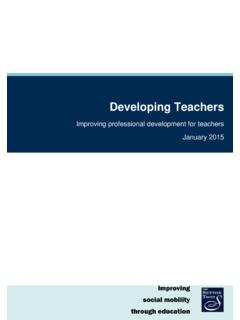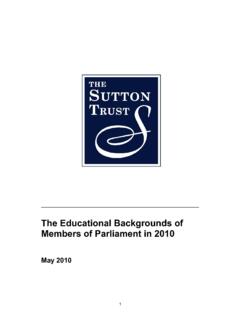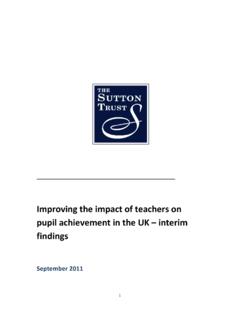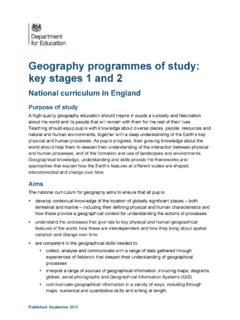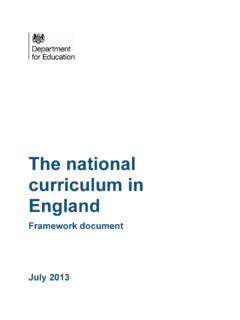Transcription of Entry into Grammar Schools in England - Sutton Trust
1 1 Entry into Grammar Schools in England Jonathan Cribb Institute for Fiscal Studies Luke Sibieta Institute for Fiscal Studies Anna Vignoles University of Cambridge Institute for Fiscal Studies 7 Ridgmount Street London WC1E 7AE Institute for Fiscal Studies 2013 2 1. Introduction In the English education system, there are 164 Grammar Schools remaining. Some of these Schools are stand-alone grammars selective Schools that coexist alongside comprehensive Schools and attract able children from a very wide geographical area. Other Grammar Schools are part of selective local authority education systems, such as those found in Kent or Buckinghamshire.
2 Whether stand-alone or part of a wider selective system, Grammar Schools have been criticised for admitting very low proportions of children from more socio-economically disadvantaged backgrounds. In this report, we attempt to shed some light on this issue by analysing the extent to which Grammar Schools and Grammar systems admit students who are eligible for free school meals and from deprived socio-economic backgrounds more generally. We also explore whether some Grammar Schools are more or less likely to admit such students, taking account of the socio-economic profile of their local area.
3 To do this, we model how family background and other pupil characteristics affect the likelihood that a pupil will attend a Grammar school . In quite general terms, there are two main reasons why pupil or family characteristics might affect their probability of attending a Grammar school . First, they might affect the probability that pupils apply to attend a Grammar school in the first place for example, due to differences in attitudes to education, beliefs in their own ability, distance from a Grammar school or perhaps a preference for single-sex schooling, given the tendency for many Grammar Schools to be single-sex.
4 Second, conditional on applying, pupils with different characteristics might have different chances of passing the test to attend a Grammar school . This could be due to differences in cognitive ability or due to different levels of preparedness for the test, though these are clearly hard to distinguish. We will compare the characteristics of pupils attending selective Schools with those of pupils attending other Schools , and provide further evidence on the likely drivers of these differences. In particular, in Section 3, we compare the characteristics of pupils attending Grammar Schools with those of pupils attending other types of Schools in the local area.
5 These characteristics include those identified in the previous literature as affecting academic achievement namely, socio-economic background, ethnicity, educational needs, month of birth, prior level of attainment at Key Stage 2 and type of primary school attended. We also examine the proportion of pupils attending Grammar Schools who are new to the state-funded system at age 11 and hence who may have transferred in from the private sector. We will then use multivariate regression analysis in Section 4 to dig deeper into how pupil characteristics directly affect the probability of attending a Grammar school for example, whether deprived pupils are less likely to attend Grammar Schools simply because they have lower levels of attainment by age 11.
6 2. Data and methodology In order to analyse the characteristics of pupils attending Grammar Schools , we use two main sources of data. First, we use the National Pupil Database, which is a large administrative data set recording every pupil in state Schools in England . This provides some limited background information on all pupils ( whether they are eligible for free school meals or whether they have English as an additional language), as well as their attainment in Key Stage 2 tests. Second, we use data from Edubase (the Department for Education s register of all educational 3 establishments in England and Wales) to identify various school characteristics and policies, such as school type and their admissions policies.
7 Together, these data sets allow us to analyse the characteristics of pupils attending Grammar Schools and other types of Schools . We are mindful that these administrative data do not contain detailed measures of individuals socio-economic background. Chowdry et al. (2013) show that eligibility for free school meals and neighbourhood-based measures of socio-economic disadvantage provide adequate proxies for an individual s socio-economic background, though clearly such measures are not ideal. Throughout, we focus on the most recent cohorts of Year 7 pupils to enter Grammar and other secondary Schools at age 11.
8 As a result of our focus on pupils in Year 7, we exclude from our analysis three Grammar Schools that start at later ages one school in Kent and two Schools in Poole. Our analysis therefore only looks at 161 of the 164 Grammar Schools remaining in England . Data available to us include the records from the National Pupil Database for three successive cohorts: those entering secondary school in September 2009, 2010 and 2011. However, much of our analysis excludes the 2010 cohort as a boycott of Key Stage 2 (KS2) tests by primary school teachers meant that attainment data for this cohort are incomplete.
9 In that year, around one-fifth of the cohort did not take the KS2 tests. Grammar Schools are not present in all local authorities. Furthermore, where they are present, they vary in their number. Kent and Buckinghamshire are still wholly selective local authorities, with 32 and 13 Grammar Schools , respectively. However, sometimes Grammar Schools are relatively isolated, with only one or two Grammar Schools in the local authority. In the latter case, we might expect the Schools to have a more selected intake, as there may be more pupils competing for places at these Schools .
10 We also expect Grammar Schools in London to show a different pattern as these Schools often have very large catchment areas in terms of pupil population as well as geography. Therefore, when we compare the characteristics of pupils attending Grammar Schools with those of other pupils in their local area, we classify local authorities into three different groups: selective local authorities identified on the basis of 10% or more pupils in the local authority attending a selective school ;1 isolated Grammar Schools local authorities containing at least one Grammar school , but with less than 10% of pupils attending a selective school .




